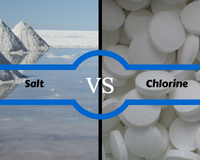An Honest Review of Plug and Play Hot Tubs: Are They Really Worth It?

Plug and play hot tubs have been on the market for years now and if you’re shopping for a tub, sooner or later you will come across that phrase. These are most-often budget-friendly tubs designed for customers who want to get up and running as fast as possible.
Can plug and play actually be that simple? For anyone looking, there are still questions around the tubs, such as:
• What does “plug and play” mean?
• How much do plug-and-play hot tubs cost?
• Will I need an electrician?
• Are plug-and-play tubs as efficient as hot tubs that are hardwired?
• What are the pros and cons of plug and play versus hardwired tubs?
• If you can make plug-and-play tubs, why aren’t all tubs plug and play?
We have answers to these questions at Hydropool because concerns about power come to our team often. What we want to do with this article is have a look at the pros and cons of 110V hot tubs, also known as “plug and play” models. There are pros and cons to this type of tub, and we will go through each so that you can make an informed decision.
What is a Plug-and-Play Hot Tub?
There are two main power sources for hot tubs. In North American you can use a 110V plug-in or a 220V hard-wired solution. In this article, we will talk mostly about a 110V plug-in option, which is often called “plug and play.”
If your response to that is “huh?” then we totally understand. Most of us are not electricians. So let’s back up.
Here’s what you need to know before you buy any hot tub. You have a choice: Plug in with a 110V or have it hardwired so you get 220V. Almost every plug-in in your house is a 110V plug-in, and almost anything you plug into an outlet is “plug and play.” Like a clock radio or phone charger, simply plug it in and it just works.
Major appliances, like your dryer or dishwasher, can require more power and as a result need special wiring or plug ins. Many hot tubs fit into that category and as a result require hardwiring.
How Much Does a 110v Plug and Play Hot Tub Cost?
Plug and play hot tubs are generally at the value end of the market. Currently plug and play hot tubs on average will cost between $5,000 and $12,000 (Cdn).
Roto mold hot tubs are at the lower end of the market between $5,000-$8,000 (Cdn) while acrylic brands are in the $8,000-$12,000 range.
Will I Need an Electrician?

Generally, no. That’s one big advantage of plug-and-play hot tubs. But you might still have a few things to figure out: If the hot tub is too far from a plug-in, you will need an extension cord. This is a tricky area, and you will want to talk to an electrician here.
This is because extension cords add unnecessary risk to your installation. They add unnecessary length and connection points, which creates potential fire hazards.
Plug-and-play hot tubs typically come with cords that are 10 feet (about 3 meters long) and that are rated to work outside. If you can’t get your hot tub close enough then you are best to call an electrician to build you a longer, custom cord or consider upgrading to 220V.
Are 110v Plug and Play Hot Tubs as Energy Efficient as 220V Hot Tubs?
The easy answer is any hot tub’s energy usage depends on how much you use the hot tub and how you use it.
If you have jets running all the time, it will use more energy. The major issue with most plug-and-play hot tubs is that you can’t run the jets and the heater at the same time. This is due to the lack of available power at your typical outlet. In North America, a 110V can typically only supply 15amps, yet in order to run all the components you would need 30 – 40amps.
What that means while the hot tub will be warm when you get in, it will struggle to keep the temperature at a high level during extended periods of use.
If you are looking to use your hot tub often, for extended periods of time or be able to have quick heat recovery while receiving a great massage, then you may want to consider calling an electrician to install a 220V line.
Does a Plug and Play Tub Cost Less or More Than a 220V tub to Operate?
The answer is: A 220V is usually cheaper over the lifetime of a tub, because having more available power allows the spa to run the heater for shorter periods of time, recovering a greater amount of heat and saving you money in the process.
How exactly? That depends on the ambient outdoor temperature and how often you use it. On average, in Canada, it should save you $5-$10 per month on your electricity bill.
A 110V tub is just as “efficient” as a 220V tub, provided both have comparable insulation systems and covers.
If you were to upgrade or convert a plug and play tub to 220V it would typically cost $1200 - $1800 upfront and then save you $5-$10 per month on your running electricity bill. That means it will take you roughly 150 months or 12.5 years to recover your upfront electrical cost. So this is the kind of decision it makes sense to get right the first time!
Are Plug & Play Hot Tubs Any Good? Pros & Cons


Why are these hot tubs called “plug and play”? The simple idea is you can choose your plug-and-play hot tub, put it on a base that is strong enough and flat enough to hold it, and then plug it in to any existing power outlet. Voila! You are soon soaking and satisfied.
Plug-in Hot Tub Pros
• It’s the easiest of all possible ways to set up your hot tub.
• These hot tubs are built to offer as much value as possible and are generally on the least expensive end of the hot tub spectrum, so if price is a major consideration for you, they are worth looking at.
• If you’re just trying out hot tubs to see if they make sense for you, then you may want to consider plug and play, because chances are good you won’t need to call an electrician if you already have outside power.
• If you want to move your hot tub – if you rent, say, plan to move or are building a cottage and want it there some day – a plug and play can make good sense.
Plug-in Hot Tub Cons & Drawbacks
An 110V tub can keep water warm, and it can power jets. But it can’t always do both at the same time, and it can’t do that as fast as or as powerful as a 220V hot tub can in any case.
A plug-and-play tub can take about three to four times as long to get to the same level of heat as a 220V tub. It can keep water warm, but it can’t adjust as easily as a 220V hot tub.
Some believe that 110V hot tubs don’t last as long or aren’t as efficient as 220V hot tubs – because they often must work harder is the thinking. But in our experience, we don’t always see it that way. What we see is that how long your hot tub lasts depends on how the hot tub is used: Someone who doesn’t stay in the hot tub for a long time and doesn’t want a lot of massage does just fine in a plug and play model and it isn’t any more expensive.
Do plug-and-play hot tubs work in the winter? If you’re in the Northern U.S. or Canada, running a hot tub in the winter with 110V means your hot tub will likely be working as hard it can the entire time to keep your water warm, increasing your costs and making your equipment work harder. And when you’re in it, you can usually run the pumps or the heat, but not both at the same time.
The larger the tub you buy, the more likely it is that 220V will work better for you. But there are eight-person plug-and-play hot tubs available if what you’re looking for is a large play area for your kids with warmed water, for example.
Acrylic tubs rarely come in the plug-and-play model. As they are higher-end hot tubs, people buying them generally want more features which require more power.
Is a Plug-and-Play Hot Tub a Good Buy?

In this article, we looked at the pros and cons of owning a plug-and-play hot tub, which is what the industry calls hot tubs that use a 110V plug in.
• A 110V plug in is standard on houses in North America, and as a result 110V plug-and-play hot tubs are popular due to their ease of setup, mobility and initial lower cost.
• But over time, most 220V tubs cost less to run, even though they cost more upfront, offer more variety and are better at quickly adjusting water temperatures, while offering full power to all other tub equipment.
Which one is right for you will come down to how you use the tub. We have sold many plug and play hot tubs to many customers with our DreamMaker series who have been very happy with the purchase. Others come back and want to convert it to a 220V, which is a choice on most plug-and-play hot tubs, or they have bought a 220V hardwired tub for their second purchase.
So who should buy an 110V plug and play tub? If you want to move your tub, want a low initial purchase price, just want it to be easily set up, live in an area where it can be hard to get an electrician – all of these are valid reasons.
But if you’re looking for a full-featured tub and you want to use all the features you can whenever you like, you’re better off looking at a 220V hot tub and getting it hard-wired.
Talk to us about either 110V plug and play hot tubs or 220V hot tubs in-store, by phone or on our Facebook page via messenger.











